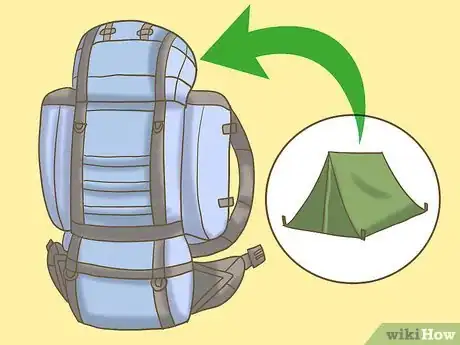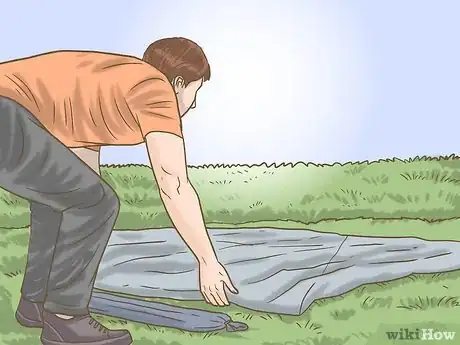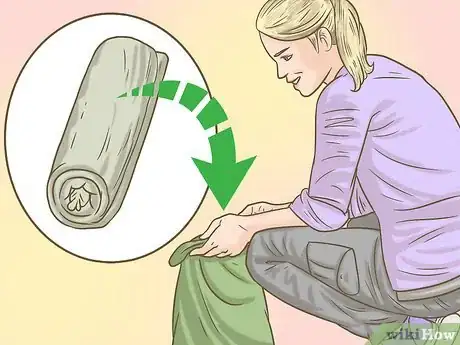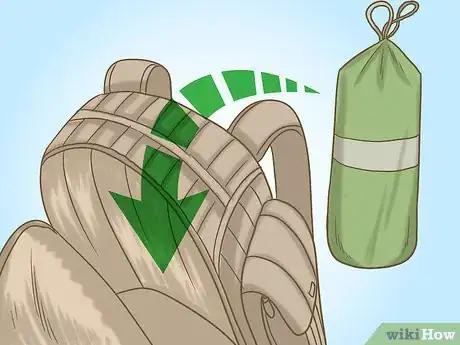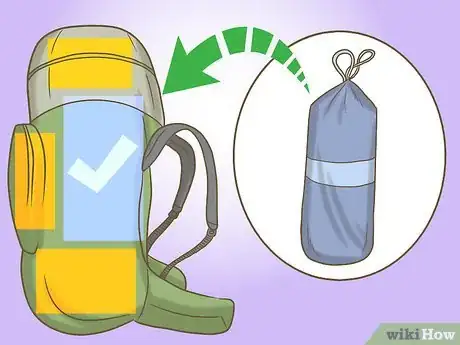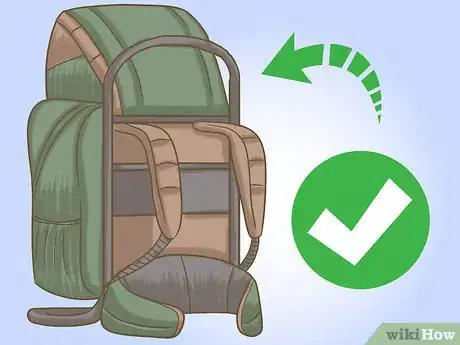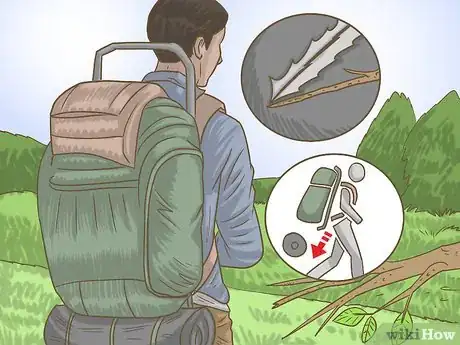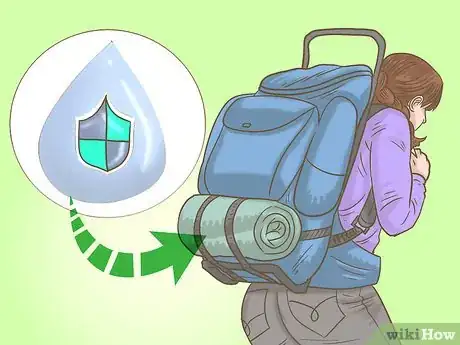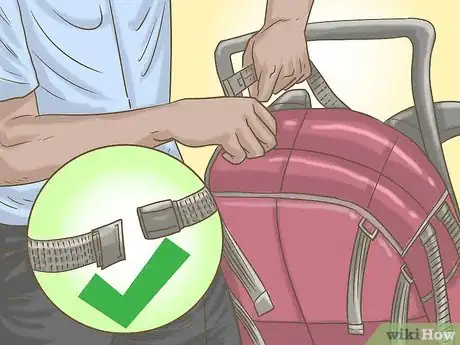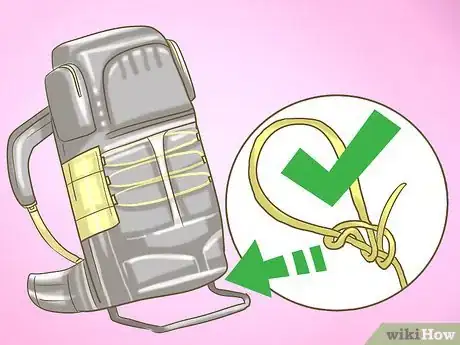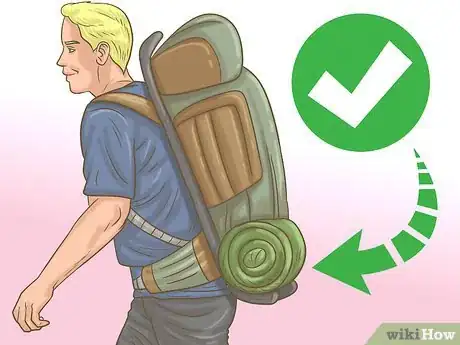This article was co-authored by Halle Payne. Halle Payne has been hiking and backpacking in Northern California for over 3 years. She was Trip Leader for Stanford University’s Outdoor Education Program, Hiking Leader for Stanford Sierra Conference Center, and has taught classes in Outdoor Education and Leave No Trace principles.
This article has been viewed 63,083 times.
Whether you're going camping or hiking, chances are you'll be doing a lot of walking with a heavy backpack. In order to make those long treks easier, you should know how the ideal ways to pack one of the heaviest items you'll have, the tent. Packing your backpack the wrong way can lead to injury and back strain. Once you pack your tent the correct way, you'll find your next outdoors experience much more enjoyable.
Steps
Packing the Tent Inside the Backpack
-
1Choose a backpack with an internal frame. Backpacks with an internal frame have more room than backpacks with an external frame. This extra space makes packing tents inside the backpack much easier. [1]
- Take into account the size of your tent when picking the backpack. Bigger tents will need bigger backpacks and vice versa.
- If you’ve already bought your backpack and you're worried that your tent is too big, look into getting a compression bag. These bags will help you pack the tent as tightly as possible.
-
2Lay your tent on the ground in a long, flat shape. With the tent poles in their bag, line the bag up along the side of the tent, not in the center. The poles help form support for the tent as you pack it away.[2]Advertisement
-
3Roll the tent. Make sure that the pole bag stays in line with the side it's on. This will make sure the tent is rolled up as straight as possible and the pole bag will provide support and a base for the tent.
- After a few rolls, lay the tent peg bag in a similar position. The goal here is to provide more support for the tent. Keep rolling the tent up.
-
4Open the tent's bag and stuff the tent into it. The pole and peg bags in the middle make this much easier by providing a central support.
- You should only pack the tent when it’s dry. Packing a wet tent is very difficult and the tent weighs more, which can make walking with it a lot harder than walking with a dry tent.
-
5Place the heavier items at the bottom of the backpack and lighter items at the top. Hiking involves a lot of walking, so it’s important to only pack around 30% of your body weight in your backpack. The lighter items should be at the top of your backpack with the heavier items further down.[3]
-
6Pack your tent in the middle of the backpack. Your sleeping bag should always be at the bottom of the pack as it can be quite heavy and it's always the last item to be taken out of the bag. The tent should be placed either immediately above the sleeping bag or as close to the middle as possible.[4]
- Packing the tent in the middle means one of your heaviest items is not putting too much strain on your back.
- Consider whether you want to pack the tent vertically or horizontally. Vertically can make the tent more accessible when you need to take it out, while horizontal placement may make packing other items on top of the tent easier.
EXPERT TIPHalle Payne has been hiking and backpacking in Northern California for over 3 years. She was Trip Leader for Stanford University’s Outdoor Education Program, Hiking Leader for Stanford Sierra Conference Center, and has taught classes in Outdoor Education and Leave No Trace principles.Hiking & Backpacking Trip Leader
 Halle Payne
Halle Payne
Hiking & Backpacking Trip LeaderOur Expert Agrees: You want items you might need during your hike easily accessible, and you wouldn't want to dig past a tent to reach those.
Attaching the Tent to the Outside of the Backpack
-
1Use a backpack with an external frame for best results. While you can definitely use an internal frame backpack, the external frame is specifically built to hold the tent and other items on the exterior.
-
2Understand the risks of packing the tent on the outside. While there are numerous advantages to packing the tent outside the backpack, there's also some significant downsides to it.
- The biggest disadvantage is the risk of snagging the tent. With the tent on the outside, it’s much more vulnerable to damage from branches and other sharp objects. If the tent snags on a branch, the branch could cut the tent and it might ruin it.
- Another risk of packing the tent outside is it may fall off of the backpack. With the tent on the inside, you can have peace of mind knowing that it’s safe. But with the tent on the outside, there’s always the chance that it could become disconnected and you could be left without a tent.
-
3Ensure the tent is protected in case of rain. While tents are waterproof, if any water gets into the tent while it’s packed up, it could spell bad news for you and your tent.
- Use a zip lock bag or another waterproof bag to store the tent for extra protection from the elements.
-
4Test your backpack to see if it's suitable for exterior packing. An external frame backpack or an internal frame backpack with plenty of compression straps will both be perfect for attaching the tent to the outside.
- Make sure the compression straps and/or the frame are in good working condition before attaching your tent.[5]
-
5Use closed loop ties on your backpack for outside packing. These loops are threaded through closed loops on both ends, so if your tent happens to slide off, it'll still be attached to your pack.
- By using this type of loop, you can at least have peace of mind that you won't lose your tent in the middle of nowhere.
- While closed loop ties work best, any secure knot should be enough to do the job.
-
6Attach the tent to the bottom of the backpack. It’s best to pack the tent at the bottom of the pack for outside packing.
- This will reduce your chances of injuring yourself by putting less strain on your back.[6]
- Placing the tent at the bottom of the pack will make it much easier to walk with than if it was attached at the top, which would make walking and moving with the backpack very awkward.
Warnings
- It needs to be stressed that the tent is much more vulnerable on the outside of the tent. Rain and branches pose a much greater threat to the tent than if it were on the inside of the backpack.⧼thumbs_response⧽
References
- ↑ https://www.outdoorintensity.com/how-to-pack-a-tent-in-a-backpack/
- ↑ https://www.youtube.com/watch?v=TV7ec3EyHos
- ↑ https://www.outdoorintensity.com/how-to-pack-a-tent-in-a-backpack/
- ↑ https://www.rei.com/learn/expert-advice/loading-backpack.html
- ↑ https://sectionhiker.com/what-are-the-straps-on-the-outside-of-a-backpack/
- ↑ https://www.outdoorintensity.com/how-to-pack-a-tent-in-a-backpack/
About This Article
If you’ll be lugging your tent a long distance, you can pack it inside your backpack to make it easier to carry. Roll your tent up tight with the poles inside and stuff it into the tent bag if you haven’t already. If you have a big camping backpack, place your sleeping bag in the bottom of your bag with the tent on top. Then, place lighter items on top and around the tent. You should also have smaller pockets on the outside of your backpack to pack other essentials. Packing the tent in the middle will reduce strain on your back when carrying the bag. For more tips, including how to attach your tent to the outside of your backpack, read on!
